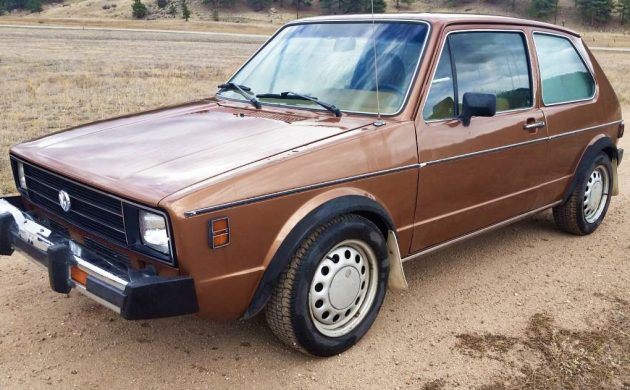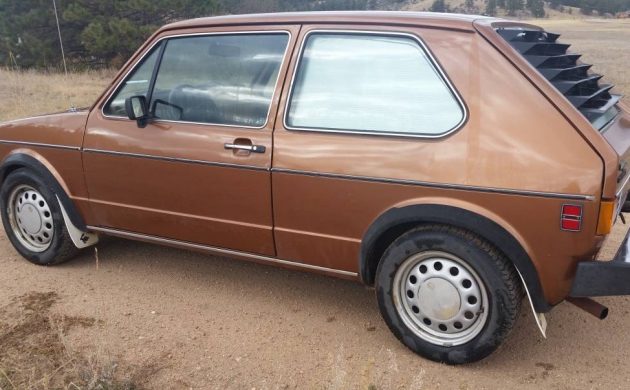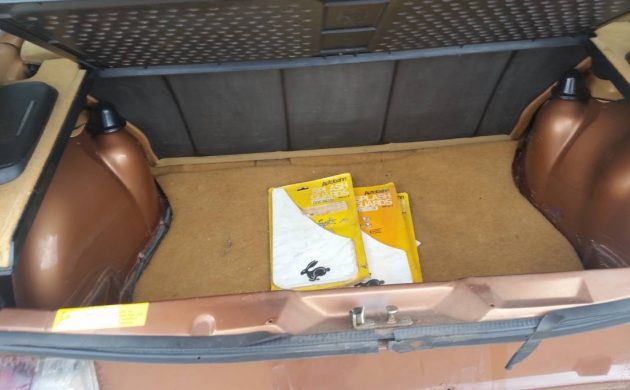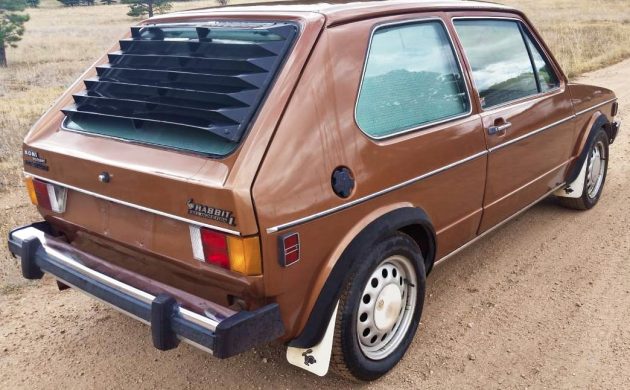This 1979 Volkswagen Rabbit is a clean survivor that remains in unrestored condition, with some great period details. The Rabbit is a gasoline model, so some enthusiasts will likely be turned off by the lack of a diesel, but that shouldn’t deter you from giving this one a look. The seller notes it has a rust-free body with an interior in excellent condition. Find it here on craigslist for $7,200 in Colorado Springs.
The Rabbit looks great on later MK2-style steel wheels with plastic wheel arch trim and OEM mudflaps. The body does look quite clean, and the brown paint is perfect for the era. The rear window louvers are another nice touch and indicative of styling trends at the time. While U.S. safety bumpers are awful in every application, at least the black plastic trim remains in nice shape.
The interior really does look as good as the seller describes, with bucket seats in seemingly beautiful condition and OEM Rabbit floormats still protecting the carpets. The steering wheel looks like a period aftermarket piece, but I’m not 100 percent sure if that’s the case. The door panels have some aftermarket speakers installed, but at least it’s in keeping with the car’s overall modified-in-period vibe.
The trunk is nearly spotless, and a set of NOS mudflaps is included. The shock towers show zero evidence of rust or really any cosmetic damage, and the privacy tray remains in place. Aftermarket speakers can be seen out back as well, so someone definitely spent some money personalizing this car back in the day.
The asking might seem a tad high, but when was the last time you came across a clean MK1 Rabbit like this one? Plus, look at the awesome rear louvers! That has to add a few miles per hour to the perceived top speed.







Wrong wheels, wrong steering wheel, gasoline engine for $7200!!! I’ll pass!
I for one like everything about it.
i had a base model automatic, 81 BHP, it kept up with traffic and up to that point was the most refined car i’d gotten to drive, my previous car was a ratty ’76 pinto so it was a BIG upgrade. cost me $2300 in ’84, had 65k miles on it. little did i know it would last only another 25k miles before it started falling apart on me. inner-body corrosion which caused the electrical system ground to fail, sometimes i’d get a shock from touching the body. the resultant shorts caused it to not start fairly often. used a quart of oil every gas-fill-up. CV joints failed at the same time, the steering would twitch when i stepped on the brake, the front end roared going down the road. the speedo stopped working, the radio stopped working, the power ventilation stopped working, the window cranked fell off and then the window mechanisms themselves got bound up and stopped working. jeez, even the driver’s seat fell apart and wouldn’t stay on its tracks, the recliner mechanism failed and the seat leaned backwards on one side. everything fell apart! this was a great pity because before all that, it was a NICE DRIVING CAR! it was quiet and smooth-riding, handled well, was fun to drive! comfortable inside, the seats fit my young body [then] well enough, no sore spots. roomy for this 6’3 person, enough headroom to wear a cap. i still miss it and wish it hadn’t have fallen apart on me.
Yikes, this gives me bad memories of the ‘79 Rabbit I had for a few months in high school twentysomething years ago. It was like this one except tan with an automatic. The electrics were messed up and it would stall out and I would have to reach under the dash and wiggle the fuel pump relay to get it going again. One day it started smoking and burning under there and that was that. One thing to note is that these cars had an early version of passive seatbelts for the front seats that were shoulder belt only, no lap belt! That big padded bolster under the dash was supposed to keep your lower half in place. VW ended up getting sued after some people were killed/paralyzed in accidents as a result of this foolish design. $7200 for a Westmoreland-built gasoline Rabbit? TBNT (Thanks But No Thanks).
A non-oil smashing engine is a plus for me.
As I recall the rectangular headlights flag this one as a US-made Rabbit. (Back in the day many people said these were of lower quality than the German-made variety, but I don’t know if that’s true.)
I have owned both in the day, and yes, there definitely was a difference in the build quality and the fit and trim of the Westmoreland Rabbits. Rattles and squeaks galore.The colored interior trim, panels, and dash would fade to many different shades within a few years. The driveline and suspension seemed to be okay, with the exception of the upper strut mounts wearing out on a yearly basis.
Updated wheels, updated steering wheel and no diesel engine,plus rear louvers! I love it!
Nope, I don’t think this is a Westmoreland. The interior, rear valance, and everything other than the rectangular headlights are German import model. If you look close, I don’t think the grille and headlights match the American builds either. I seem to remember they had to import Rabbits until the Westmoreland plant was up and running in 1979. Steering wheel isn’t stock.
Nope, definitely a Pennsylvania Rabbit. The German models had round headlights and rectangular side marker lights. As per Wikipedia – The factory manufactured a range of fuel-efficient small cars with gasoline and diesel engines, all variants (or rebadged models) of Volkswagen’s Golf: the Rabbit (79–84); Rabbit GTI (83–84); Rabbit Pickup (1979–1982); the Golf Mk2 and GTI (85–89) and the Jetta (87–89). Built with the largest incentive package the Commonwealth of Pennsylvania had ever offered, the factory had an estimated annual capacity of 240,000 cars, and reached production of 200,000 in 1980.[1] Engines and drivetrains for Westmoreland production were sourced from Germany.[1] Employment, projected at 20,000, reached its highest level in mid-1981 at 6,000 [6] and by 1984 had dropped to 1,500.
Seams like a unicorn. Match it to any US model, the grille and square headlights are different and made specifically for the German round headlight front end. The US-only had different fenders and radiator support (wrap around turn signals). I’m not saying your wrong about the origin, but nothing else about the car says US to me (dash, rear valance, knee pad). I can’t find another front end like that to confirm on google, so either way it seems a unicorn.
Sorry, I may want to clarify. I shouldn’t say it’s not a Westmoreland car, because there were no German built cars with square headlights. It’s different than any I’ve seen though, having all the German features. Did yours have the German interior too?
The interiors were similar, but different. I had a 1978 and 1980, both with the Rabbit C trim. The 1980 had the same grill, headlights and side marker lights as this car does. The 1978 had a black dash, black steering wheel, no knee bolster, the turn single and wiper switches were black and nothing was color matched. The seats were textured VW TEX similar to the beetle and other earlier VW’s. The 1980 had a knee bolster and color matched everything! The actual instrument cluster, not the dash, is the only thing that was the same as the 78. The seats were also different, they were smooth vinyl with no texture. The inside of that car was an ocean of blue plastic and vinyl. I really liked the 1978 interior much better. As far as performance, the 1978 was a 4 speed manual and 1.6L FI and I believe the 1980 was a 5 speed with a 1.7L FI. Other than that, they drove and handled the same. I may have pictures of both cars somewhere. If I can find them, I’ll upload them to this post.
My late brother had one of these (not sure of the year) in the prettiest green. If I ever saw a pristine one in that color, I’d have to buy it.
Funny how “lack of a diesel” is mentioned as a negative. Back in the day except for a few years when gas prices peaked, you couldn’t give away the diesels (the fact that most people could WALK away faster than the car would go didn’t help).
I should know…I had one in the early 80s. New off the lot, it was a great deal given the undesirable engine. With a 4 speed manual, the car would actually eventually get to and cruise comfortably at 80, but you had to drive it like you stole it to get it to that speed. Plus it smelled like a bus. Good times.
I built and drove (and crashed) a lot of Rabbits in the old days. There were always two kinds of owners – guys who liked to drive who wouldn’t touch the diesel with a long stick, and the diesel guys who wanted to thumb themselves in front of a log book talking about their achievement in fuel. To be fair, a diesel rabbit is a fine vehicle to get someplace slowly, but gasoline tells the rest of us to “make it quicker, make it quicker!”
I think a lot of the comparisons previous posters are using as to whether this was a German or US-built example are hinging on easy to swap items. My recollection is that there was never a knee-guard like this is a 1980 Rabbit. In fact, I think it was introduced with the update to the Cabriolet in the mid-’80s. The square headlight and grill assembly without marker lights and turn indicators is definitely correct for a US-bound car in 1980. Just like the Scirocco, they didn’t extend the marker light around until they had time to economically rework the sheet metal — which is why they screwed those unseemly lights onto the sides of the front and rear fenders.
The Rabbits with the passive seatbelts always had the knee pad from 1975-1980. They also got the knee pad with air conditioning.
This is a late reply to your late reply, but who knows, if I’m reading it this long after the fact, someone else might, too.
You are correct about the knee pad. My first brand new car was a ’79 Rabbit C. The AC cars had the knee pad, non AC cars did not. It had something to do with protecting or hiding the components of the AC system. I wanted AC and liked that extra tray which the knee pad provided, but AC added $600 to a $6k car, and that was a budget buster. No big deal, though. That was back in the day when very few houses or new/used cars had AC in the Midwest and people could actually survive without it.
If I had to drive a hatchback I wanted it to be zippy, unlike the slow as molasses diesel version, so I bought a bright red, non AC (no knee pad) “C” level trim with the fuel injected gas engine, 5 speed stick, and only a few minor options to keep it under $6k.
It served me well for a couple of years with no problems until I traded up for something fancier in ’81.
About the time of this car, my new wife and I were looking for a new small car to replace her Pontiac Ventura SJ. The Rabbit was one of the prospective cars on our list, but we were unimpressed on the test drive, and especially with the fit and finish of the interior. We went with a new 1980 Honda Civic hatchback, and were very happy. Had the Honda for close to 10 years, and the only problem was the quality of 1980’s Japanese steel, and parts of the car started to rot away in Long Island winters.
I still have a many parts for those perfect car
Old Good VW
Clean car! I would remove the rear louvers, add Neuspeed lowering springs, GTI rims, round headlight conversion and euro bumpers font and back. Then she’s perfect!!
My dad had a 1979 VW rabbit, a dark brown one, that he had stored in his garage from 1995 until 2012. Dad gave it to his grandson (my nephew), but I don’t know what became of it. All I know is that years earlier dad had put another motor in it, but could not get it to run because it needed a certain part. So it just sat in the garage (he was getting up in years). Anyway the body and paint were still in nice shape on it. I told my nephew that the replacement engine was in the car and all he had to do was get it running. I believe he intended to do just that. But again, I’m not sure what became of it.
Bought a ’78 2 door with sunroof brand new. Made in Germany, “Dakota Beige” was the color. Fun great driving car. Ran it for 80,000 miles with no real problems. Finally the fuel pump relay started failing, turned out to be a faulty fuse panel ground. VW shop manager fixed it in about 10 minutes out in the parking lot.
I don’t know about the ’78s, but I had a new ’79, and it had a recall for that same issue later in ’79 or maybe ’80. It was the only time it was ever back at the dealership. It was a fun, zippy car that got excellent mileage and got me through the ’79 gas crisis without a problem while many/most others were stuck with 12 mpg ’70s land yachts.
These PA built Rabbits were a far cry from their German built brethren… pass.
I hope this comment box isn’t dead, but I’m trying to track down the original owner. I just purchased this same car from a guy in San Diego and will like to talk to the real owner because there was some work done to the engine and will like to know more.. (Jeff, do you have the contact info of the Original owner?)
All the info we have is right here on the page.